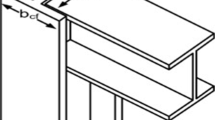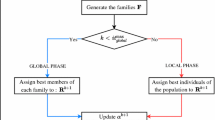Abstract
The building design community is currently experiencing a shift towards generating more resilient and sustainable designs that are also safe and economic. Integrating these broad, often conflicting, factors into design causes the design process to become more complex, the decisions more difficult, and a need for higher fidelity (and more expensive) modeling efforts to gain insight to resolve these tradeoffs. Set-based design is a promising alternative to traditional point-based design for such complex design problems because many design concepts are generated, refined and carefully eliminated throughout the process thereby maintaining significant freedom in the early stages of design. There is an emerging concept of closely coupling set-based design with model-based simulation to systematically contract the design space through a sequence of modeling efforts in which bounding models are constructed to guarantee the antecedent model only eliminates design alternatives that are dominated when analyzed using a subsequent higher fidelity model. In this paper, the concept of the sequential decision process is explored for the system-level design of seismic-resisting structural frames using nonlinear static analysis. Bounding models are derived for this design problem that are sufficiently general for various types of structural frames. The merit of the novel approach lies in giving designers the ability to search the tradespace exhaustively, arriving at the global minimum with a reduced cost by comparison to a full evaluation using the highest fidelity model while also providing the freedom to retain dominated and non-dominated solutions.

















Similar content being viewed by others
References
Abramowitz M, Stegun, IA (1964) Handbook of mathematical functions: with formulas, graphs, and mathematical tables. Dover Publications Inc, New York, NY
Achtziger W, Stolpe M (2007) Truss topology optimization with discrete design variables - guaranteed global optimality and benchmark examples. Struct Multidiscip Optim 34(1):1–20
AISC (2010) Seismic provisions for structural steel buildings. American Institute of Steel Construction. AISC, Chicago
AISC (2011) Steel construction manual. American Institute of Steel Construction, Chicago
Applied Technology Council (1996) Seismic evaluation and retrofit of concrete buildings. Report ATC 40
Asadpoure A, Guest JK, Valdevit L (2015) Incorporating fabrication cost into topology optimization of discrete structures and lattices. Struct Multidiscip Optim 51(2):385–396
American Society of Civil Engineers. (2007). Seismic rehabilitation of existing buildings, ASCE Publications, 41(6):64–71. Reston, VA
Balling RJ (1991) Optimal steel frame design by simulated annealing. J Struct Eng 117(6):1780–1795
Coello Coello CA, Lamont GB, Van Veldhuizen DA (2007) Evolutionary algorithms for solving multi-objective problems. Springer Science and Business Media, New York
Bellman R (1957) Dynamic programming. Princeton University Press, Princeton
Bendsoe MP, Sigmund O (2013) Topology optimization: theory, methods, and applications. Springer, Berlin
Bloebaum CL, McGowan AR (2012) The design of large-scale complex engineered systems: present challenges and future promise. Proceedings of the 14th AIAA/ISSMO multidisciplinary analysis and optimization conference, Indianapolis, IN, paper no. AIAA-2012-5571
Busemeyer JR, Townsend JT (1993) Decision field theory: a dynamic-cognitive approach to decision making in an uncertain environment. Psychol Rev 100(3):432
Chopra AK, Goel RK (1999) Capacity-demand-diagram methods based on inelastic design spectrum. Earthquake Spectra 15(4):637–656
Deb K, Pratap A, Agarwal S, Meyarivan T (2002) A fast elitist multi-objective genetic algorithm: NSGA-II. IEEE Trans Evol Comput 6(2):182–197
Deierlein GG, Reinhorn AM, Willford MR (2010) Nonlinear structural analysis for seismic design. NEHRP Seismic Design Technical Brief No 4
Department of Defense (2010) Design of buildings to resist progressive collapse. UFC 4-023-03
Dogruel S, Lavan O, Dargush GF (2008) A unified framework for evolutionary optimization with application to structural engineering. International conference on engineering optimization, Rio de Janeiro, Brazil
FEMA (1997) NEHRP guidelines for the seismic rehabilitation of buildings. FEMA 273
FEMA (2000) Recommended seismic design criteria for new steel moment frame buildings, FEMA 350. Federal Emergency Management Agency, Washington
FEMA (2006) NEHRP recommended provisions: design examples (FEMA 451). Federal Emergency Management Agency, Washington
Foutch DA, Yun SY (2002) Modeling of steel moment frames for seismic loads. J Constr Steel Res 58(5):529–564
Fragiadakis M, Lagaros N, Papadrakakis M (2006) Performance-based multiobjective optimum design of steel structures considering life-cycle cost. Struct Multidiscip Optim 32:1
Frangopol DM, Kallen MJ, Van Noortwijk JM (2004) Probabilistic models for life-cycle performance of deteriorating structures: review and future directions. Prog Struct Eng Mater 6(4):197–212
Frey DD, Herder PM, Wijnia Y, Subrahmanian E, Katsikopoulos K, Clausing DP (2009) The pugh controlled convergence method: model-based evaluation and implications for design theory. Res Eng Des 20(1):41–58
Hayalioglu MS (2001) Optimum load and resistance factor design of steel space frames using genetic algorithm. Struct Multidiscip Optim 21(4):292–299
Koboevic S, Rozon J, Tremblay R (2012) Seismic performance of low-to-moderate height eccentrically braced steel frames designed for north American seismic conditions. J Struct Eng 138(12):1465–1476
Lagaros ND, Papadrakakis M (2007) Robust seismic design optimization of steel structures. Struct Multidiscip Optim 33(6):457–469
Lee SI, Bae JS, Cho YS (2012) Efficiency analysis of set-based design with structural building information modeling (S-BIM) on high-rise building structures. Autom Constr 23:20–32
Li G, Jiang Y, Yang D (2012) Modified-modal-pushover-based seismic optimum design for steel structures considering life-cycle cost. Struct Multidiscip Optim 45(6):861–874
Marjanishvili S, Agnew E (2006) Comparison of various procedures for progressive collapse analysis. J Perform Constr Facil 20(4):365–374
Mazzoni S, McKenna F, Scott MH, Fenves GL (2006) OpenSees command language manual. Pacific Earthquake Engineering Research Center, Berkeley, CA
Miller SW, Simpson TW, Yukish MA, Bennett LA, Lego SE, Stump GM (2013) Preference construction, sequential decision making, and trade space exploration. ASME 2013 International design engineering Technical conferences and computers and information in engineering conference
Miller SW, Simpson TW, Yukish MA (2015) Design as a sequential decision process: a method for reducing design set space using models to bound objectives. ASME 2015 International design engineering Technical conferences and computers and information in engineering conference. American Society of Mechanical Engineers, 2015
Moehle J, Deierlein GG (2004) A framework methodology for performance-based earthquake engineering. In 13th world conference on earthquake engineering. pp 3812-3814
Pareto V (1971) Manual of political economy. A. M. Kelley, New York
Payne JW, James RB, Eric JJ (1993) The adaptive decision maker. Cambridge University Press, New York
Pezeshk S, Camp CV, Chen D (2000) Design of nonlinear framed structures using genetic optimization. J Struct Eng 126(3):382–388
Ross AM, Hastings DE (2005) The tradespace exploration paradigm. INCOSE Int Symp 15(1):1706–1718
Sarkisian M, Long E, Shook D, Doo CS (2009) Optimization tools for the design of structures. In: Proceedings of 78th convention for structural engineers association of California (SEAOC). San Diego, CA
Sarkisian M, Shook D (2014) Embodied carbon in our future cities, in CTBUH, ctbuh.Org/papers
Shocker AD, Ben-Akiva M, Boccara B, Nedungadi P (1991) Consideration set influences on consumer decision-making and choice: issues, models, and suggestions. Mark Lett 2(3):181–197
Simpson TW, Spencer DB, Yukish MA, Stump GM (2008) Visual steering commands and test problems to support research in trade space exploration. I12th AIAA/ISSMO Multidisciplinary Analysis and Optimization Conference. Reston, Virigina, AIAA-2008-2139 pp 1–15
Simpson TW, Carlsen D, Malone M, Kollat J (2011) Trade space exploration: assessing the benefits of putting designers “back-in-the-loop” during engineering optimization. In Human-in-the-Loop Simulations Springer London pp 131–152
Singer DJ, Norbert D, Michael EB (2009) What is set-based design? Nav Eng J 121(4):31–43
Sobek DKI (1996) A set-based model of design. Mech Eng 118(7):78–81
Sobek DKI, Liker JK, Ward AC (1998) Another look at how Toyota integrates product development. Harv Bus Rev 76(4):36–47
Sobek DKI, Ward AC, Liker JK (1999) Toyota’s principles of set-based concurrent engineering. Sloan Manag Rev 40(2):67–83
Stolpe M (2015) Truss topology optimization with discrete design variables by outer approximation. J Glob Optim 61(1):139–163
Stromberg LL, Beghini A, Baker WF, Paulino GH (2011) Application of layout and topology optimization using pattern gradation for the conceptual design of buildings. Struct Multidiscip Optim 43(2):165–180
Stump GM, Lego SE, Yukish MA, Simpson TW, Donndelinger JA (2009) Visual steering commands for trade space exploration: user-guided sampling with example. J Comput Inf Sci Eng 9(4):04450-1–044501-10
Tsetsos K, Marius U, Nick C (2010) Preference reversal in multiattribute choice. Psychol Rev 117(4):1275
Venkataraman S, Haftka RT (2004) Structural optimization complexity: what has Moore’s law done for us? Struct Multidiscip Optim 28(6):275–287
Viana FAC, Simpson TW, Toropov V, Balabanov V (2014) Metamodeling in multidisciplinary design optimization: how fare have we really come? AIAA J 52(4):670–690
Wang J, Terpenny J (2003) Interactive evolutionary solution synthesis in fuzzy set-based preliminary engineering design. J Intell Manuf 14(2):153–167
Ward AC (1989) A theory of quantitative inference for artifact sets, applied to a mechanical design compiler. Doctoral dissertation, Massachusetts Institute of Technology
Zuo W, Saitou K (2016). Multi-material topology optimization using ordered SIMP interpolation. Struct Multidiscip Optim 55:1–15
Acknowledgements
The authors acknowledge support from the National Science Foundation (NSF) under NSF Grant CMMI-1455444. Any opinions, findings, and conclusions or recommendations expressed in this paper are those of the authors and do not necessarily reflect the views of the National Science Foundation. This material is also supported by the U.S. Department of Defense through the Systems Engineering Research Center (SERC) under Contract H98230-08-D-0171. SERC is a federally funded University Affiliated Research Center managed by the Stevens Institute of Technology.
Author information
Authors and Affiliations
Corresponding author
Rights and permissions
About this article
Cite this article
Unal, M., Miller, S.W., Chhabra, J.P.S. et al. A sequential decision process for the system-level design of structural frames. Struct Multidisc Optim 56, 991–1011 (2017). https://doi.org/10.1007/s00158-017-1697-1
Received:
Revised:
Accepted:
Published:
Issue Date:
DOI: https://doi.org/10.1007/s00158-017-1697-1




